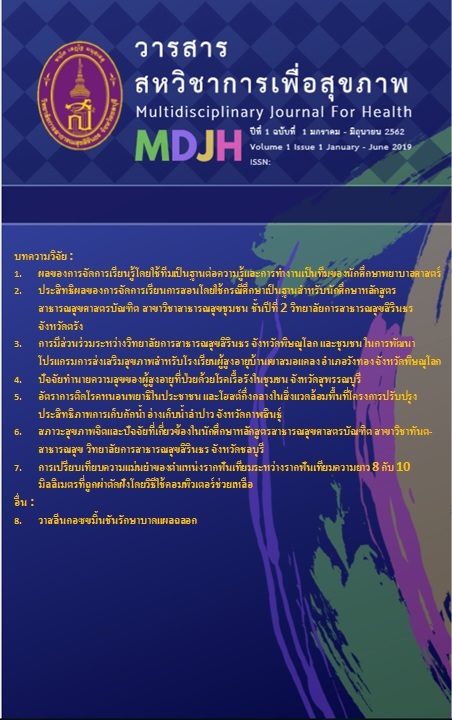การเปรียบเทียบความแม่นยำของตำแหน่งรากฟันเทียมระหว่างรากฟันเทียม ความยาว 8 กับ 10 มิลลิเมตรที่ถูกผ่าตัดฝังโดยวิธีใช้คอมพิวเตอร์ช่วยเหลือ
คำสำคัญ:
ความแม่นยำของตำแหน่งรากฟันเทียม, การผ่าตัดฝังรากฟันเทียมโดยวิธีใช้คอมพิวเตอร์ช่วยเหลือ, ความยาวของรากฟันเทียม 8 และ 10 มิลลิเมตรบทคัดย่อ
วัตถุประสงค์: เพื่อเปรียบเทียบความแม่นยำของตำแหน่งรากฟันเทียมโดยวัดค่าความคลาดเคลื่อนระหว่างรากฟันเทียมมยาว 8 กับ 10 มม. ที่ถูกผ่าตัดฝังในขากรรโดยวิธีใช้คอมพิวเตอร์ช่วยเหลือ วิธีการศึกษา: ผู้ที่ต้องการใส่รากฟันเทียมแบบซี่เดี่ยวทดแทนฟันธรรมชาติถูกสุ่มแบ่งเป็น 2 กลุ่ม เพื่อรับการผ่าตัดใส่รากฟันเทียมความยาว 8 หรือ 10 มม. กลุ่มละ 12 ซี่ ผู้ป่วยจะได้รับการผ่าตัดฝังรากฟันเทียมโดยใช้คอมพิวเตอร์ช่วยเหลือ ความคลาดเคลื่อนของตำแหน่งรากฟันเทียมในแนว 3 มิติ จะถูกประเมินโดยใช้ภาพรังสีส่วนตัดอาศัยคอมพิวเตอร์ชนิดโคนบีม (CBCT) ร่วมกับคอมพิวเตอร์ซอฟต์แวร์ ผลการศึกษา: ความคลาดเคลื่อนเฉลี่ยเชิงมุมมีค่า 3.18°±1.84° และ 5.24°±1.25° ความคลาดเคลื่อนเฉลี่ยที่ขอบบนรากฟันเทียมมีค่า 1.14±0.60 มม. และ 1.27±0.60 มม. และความคลาดเคลื่อนเฉลี่ยที่ตำแหน่งปลายรากฟันเทียมคือ 1.39±0.63 มม. และ 1.90±0.51 มม. ในกลุ่มรากฟันเทียมยาว 8 มม.และกลุ่ม 10 มม.ตามลำดับ ความคลาดเคลื่อนเชิงมุมและความคลาดเคลื่อนที่ตำแหน่งปลายรากฟันเทียมของกลุ่มรากฟันเทียมยาว 8 มม.มีค่าน้อยกว่ากลุ่ม 10 มม.อย่างมีนัยสำคัญทางสถิติที่ระดับ 0.05 สรุป: การผ่าตัดฝังรากฟันเทียมโดยใช้คอมพิวเตอร์ช่วยเหลือในรากฟันเทียมยาว 8 มม.แม่นยำกว่ารากฟันเทียมยาว 10 มม.
คำสำคัญ: ความแม่นยำของตำแหน่งรากฟันเทียม การผ่าตัดฝังรากฟันเทียมโดยวิธีใช้คอมพิวเตอร์ช่วยเหลือ ความยาวของรากฟันเทียม 8 และ 10 มิลลิเมตร
เอกสารอ้างอิง
Bidra, A. S. (2010). Surgical and prosthodontic consequences of inadequate treatment planning for fixed implant-supported prosthesis in the edentulous mandible. Journal of Oral and Maxillofacial Surgery, 68(10), 2528-2536.
Bidra, A. S. (2011). Consequences of insufficient treatment planning for flapless implant surgery for a mandibular overdenture: a clinical report. J Prosthet Dent, 105(5), 286-291.
Block, M. S., Emery, R. W., Lank, K., & Ryan, J. (2017). Implant Placement Accuracy Using Dynamic Navigation. Int J Oral Maxillofac Implants, 32(1), 92-99.
Bover-Ramos, F., Vina-Almunia, J., Cervera-Ballester, J., Penarrocha-Diago, M., & Garcia-Mira, B. (2018). Accuracy of Implant Placement with Computer-Guided Surgery: A Systematic Review and Meta-Analysis Comparing Cadaver, Clinical, and In Vitro Studies. Int J Oral Maxillofac Implants, 33(1), 101-115.
Buser, D., Martin, W., & Belser, U. C. (2004). Optimizing esthetics for implant restorations in the anterior maxilla: anatomic and surgical considerations. Int J Oral Maxillofac Implants, 19(7), 43-61.
Cooper, L. F. (2016). Prosthodontic complications related to non-optimal dental implant placement. In S. J. Froum (Ed.), Dental Implant Complications: Etiology, Prevention, and Treatment, (pp. 539-558).
Ersoy, A. E., Turkyilmaz, I., Ozan, O., & McGlumphy, E. A. (2008). Reliability of implant placement with stereolithographic surgical guides generated from computed tomography: clinical data from 94 implants. J Periodontol, 79(8), 1339-1345.
Farley, N. E., Kennedy, K., McGlumphy, E. A., & Clelland, N. L. (2013). Split-mouth comparison of the accuracy of computer-generated and conventional surgical guides. Int J Oral Maxillofac Implants, 28(2), 563-572.
Fortin, T., Loup Coudert, J., Champleboux, G., Sautot, P., & Lavallée, S. (1995). Computer-assisted dental implant surgery using computed tomography. Journal of Image Guided Surgery, 1(1), 53-58.
Grunder, U., Gracis, S., & Capelli, M. (2005). Influence of the 3-D bone-to-implant relationship on esthetics. International Journal of Periodontics and Restorative Dentistry, 25(2).
Jung, R. E., Schneider, D., Ganeles, J., Wismeijer, D., Zwahlen, M., Hammerle, C. H., & Tahmaseb, A. (2009). Computer technology applications in surgical implant dentistry: a systematic review. Int J Oral Maxillofac Implants, 24 Suppl, 92-109.
Kiani, S., Razavi, S. M., Movahedian, B., & Khalesi, S. (2015). The Effect of Common Local and Systemic Conditions on Dental Implant Osseointegration: A Review of Literature. Avicenna J Dent Res., 7(2), e24339. doi:10.17795/ajdr-24339
Lee, C. K., & Agar, J. R. (2006). Surgical and prosthetic planning for a two-implant–retained mandibular overdenture: A clinical report. J Prosthet Dent, 95(2), 102-105.
Moraschini, V., Poubel, L. d. C., Ferreira, V., & dos SP Barboza, E. (2015). Evaluation of survival and success rates of dental implants reported in longitudinal studies with a follow-up period of at least 10 years: a systematic review. Int J Oral Maxillofac Implants, 44(3), 377-388.
Porter, J. A., & Von Fraunhofer, J. A. (2004). Success or failure of dental implants? A literature review with treatment considerations. Gen Dent., 53(6), 423-432.
Porwal, A., & Sasaki, K. (2013). Current status of the neutral zone: a literature review. J Prosthet Dent, 109(2), 129-134.
Ruppin, J., Popovic, A., Strauss, M., Spüntrup, E., Steiner, A., & Stoll, C. (2008). Evaluation of the accuracy of three different computer-aided surgery systems in dental implantology: optical tracking vs. stereolithographic splint systems. Clinical oral implants research, 19(7), 709-716.
Sicilia, A., & Botticelli, D. (2012). Computer guided implant therapy and soft and hard tissue aspects. The Third EAO Consensus Conference 2012. Clin Oral Implants Res, 23 Suppl 6, 157-161.
Somogyi-Ganss, E., Holmes, H. I., & Jokstad, A. (2015). Accuracy of a novel prototype dynamic computer-assisted surgery system. Clin Oral Implants Res, 26(8), 882-890.
Tahmaseb, A., Wismeijer, D., Coucke, W., & Derksen, W. (2014). Computer technology applications in surgical implant dentistry: a systematic review. Int J Oral Maxillofac Implants, 29, 25-42.
Tardieu, P. B., & Rosenfeld, A. L. (2009). The art of computer-guided implantology: Quintessence Pub.
Tarnow, D. P., Cho, S., & Wallace, S. (2000). The effect of inter-implant distance on the height of inter-implant bone crest. J Periodontol, 71(4), 546-549.
Van Assche, N., Vercruyssen, M., Coucke, W., Teughels, W., Jacobs, R., & Quirynen, M. (2012). Accuracy of computer-aided implant placement. Clin Oral Implants Res, 23 Suppl 6, 112-123.
Widmann, G., & Bale, R. J. (2006). Accuracy in computer-aided implant surgery--a review. Int J Oral Maxillofac Implants, 21(2), 305-313.



